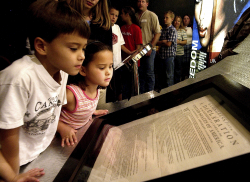The Ring cycle, Richard Wagner’s four-part meditation on the human condition—told through the composer’s harmonization and embellishment of Norse myths about the creation and destruction of the world—is enjoying an international renaissance. In Europe, the principal theaters of London, Paris, Milan, Munich, and Monte Carlo are all at various stages in the process of unfurling new productions by the celebrated directors Barrie Kosky, Calixto Bieito, Sir David McVicar, Tobias Kratzer, and Davide Livermore, respectively. In North America, the Atlanta Opera will conclude its ongoing Ring cycle next spring, while the Metropolitan Opera has engaged the provocateur Yuval Sharon to direct a new production by the end of the decade.
Here in Vienna, the Staatsoper continues to rely on the actor-turned-director Sven-Eric Bechtolf’s serviceable production, which premiered in 2007–09. To say it is a warhorse could be taken quite literally—when the Valkyrie warrior maidens take the stage, full-sized, if immobile, model horses appear. Bechtolf offers no sweeping ideological interpretation, but that is arguably one of his production’s strengths. Over the last half century, various Ring productions have advanced tendentious commentary about ecology, migration, feminism, capitalism, consumerism, energy politics, and other politically modish topics that are often tangential to the work, which Wagner said is simply life upon the stage, and is usually best treated as a lens on humanity’s many failings and few virtues. Taking a simpler approach hazards derision in the German intellectual world for being “idea-less” (ideelos)—and, indeed, some previous critiques accused Bechtolf of lacking imagination. Nevertheless, it is hard to find fault with simply telling the epic story. The Ring, the director told an interviewer, is fundamentally about “the world” and “the people in it”—that is to say, it is about us.
For the most part, Bechtolf remains true to Wagner’s extensive stage directions and notated commentary, the latter of which dates back to the Ring’s premiere—which opened the composer’s self-designed Festspielhaus in Bayreuth in 1876. The action opens in the depths of the Rhine, where aquatic maidens guard a precious treasure of gold. Only Alberich, a Nibelung dwarf who has foresworn love, may steal it and, after forging it into a ring, claim all power in the world. This becomes a problem for the chief god, Wotan, who must already compensate the giants Fafner and Fasolt for constructing his castle Valhalla. The original bounty was the goddess Freia, whose magic apples maintain the gods in youth and vigor. Substituting Alberich’s treasure seems like a good alternative until Wotan learns he must also surrender the ring, on which Alberich has placed a curse that will bring death to anyone who touches it. The dilemma sets off an intergenerational conflict of hatred, envy, rage, despair, treachery, and revenge that eventually consumes the world in flames only for it to be redeemed through the self-sacrifice of Wotan’s daughter Brünnhilde, a goddess reduced to humanity through her love for Wotan’s semi-divine offspring, the incestuous twins Siegmund and Sieglinde, and their orphaned son Siegfried.
Rolf Glittenberg’s sets rely heavily on curtains, shades, and shadows, with an off-white color dressing most scenes. Moments of extreme emotion are illuminated in a fairly simple color scheme, with rotations among green, red, and purple for different moments of passion and crime. Friedrich Zorn’s video projections were probably state-of-the-art earlier this century but now appear hopelessly outdated in a world ever more given to computer generated imagery. Glittenberg’s wife, Marianne, created reasonable costumes for a cast of eccentric deities and vigorous mortals, though these days the leather-jacketed main characters look rather more like figures on the extreme end of Europe’s New Right. Some weird features include the turning of the Nibelung treasure into golden human arms, legs, and heads, and the creation of steampunk surroundings as the action shifts from the realm of the gods to the mortals digs.
Multiple casts of the world’s leading Wagner singers have rotated through Bechtolf’s production over the years. This time, the standouts by far were Andreas Schager’s towering Siegfried and Anja Kampe’s radiant Brünnhilde. Schager was equally impressive in the role of Siegfried’s father Siegmund, for which another tenor is typically cast due to the excessive vocal demands. This Ring, which unfolded over nine days instead of the usual six, however, clearly provided enough recovery time for Schager to perform both parts across three of the operas with seemingly boundless energy and natural heldentenor highs. Kampe’s sturdy soprano never faltered in Brünnhilde’s demanding appearances, producing gleaming Bs and Gs across Die Walküre, perfectly formed Cs in Siegfried, and pure stamina and defiance in Götterdämmerung. It is no exaggeration to say that the duo are the leading exponents of their roles right now.
Among the remaining cast, the talented baritone Jochen Schmeckenbecher delivered a lively and bitter Alberich, relishing the part’s hate and envy without yielding to the victimhood some commentators choose to see in him. The lower female roles of Wotan’s suffering wife Fricka and the earth goddess Erda, whom he seduces into bearing the Valkyries, were filled effectively by Monika Bohinec and Anna Kissjudit. Samuel Youn’s bass-baritone may have sat a little too high for Alberich’s son Hagen, who should be performed, as Wagner indicated, by a “deep bass,” but he was entertaining in the role. Michael Laurenz sang a sprightly Loge, the god of fire and trickery who gets Wotan both into and out of divine jams. Bass Kwangchul Youn, who has had an impressive career mainly on German stages, sounded a bit underpowered as the giant Fafner and as Sieglinde’s unloved husband Hunding, but was a reassuring presence. Ilja Kazakov, who sang Fasolt, the other giant, unrolled a strumming bass line and strong, steady legato that presage a fine Wagnerian career.
The weakest vocal link was the Scottish baritone Iain Paterson, who was cast as Wotan. Paterson, a familiar exponent of the role on this side of the Atlantic, never quite had the heft for the character beyond his lighter moments in the first Ring opera, Das Rheingold. He started out credibly but, booed at that performance’s curtain calls, then steadily faded in the role’s heavier Walküre incarnation. By the time we got to Siegfried, he was barely audible over the orchestra. After the first act he was announced to be suffering from a severe allergy but unfortunately persisted in singing. The audience understood, and he gestured his forefinger and thumb to his throat in the shape of a gun at curtain calls, but it would certainly have been wiser for him to have channeled Wotan’s renunciation instincts and yielded the rest of the performance to a cover. One recalls that Paterson himself replaced an unwell Wotan in the entire run of Paris’s new Rheingold production earlier this year, so the lesson should not have been lost.
A highlight of the production arrived in Vienna’s music director Philippe Jordan. His earlier performances of the Ring operas, in Paris notably, were glacially slow affairs. In subsequent performances elsewhere, he later added a Gallic flair that sped things up and lent a lighter touch. Here, however, with Vienna’s superb orchestra at his full disposal, he led a fierce and driving performance that spared nothing in percussion or horns, reminding us that Wagner did once say he would be perfectly content if he only ever composed for the horns. Despite the unevenness in casting and worn-out production, Jordan’s Ring is one for the orchestral records.

















